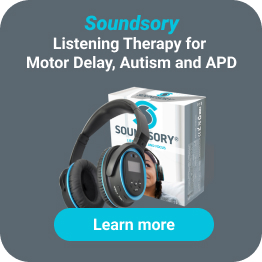How can primitive reflex integration exercises help with Autism and ADHD?
 Kara Tavolacci
Kara Tavolacci SIPT Certified Occupational Therapist
December 18, 2023
Exercises included in this free guide.
Introduction
We are excited to share with you how primitive reflex integration exercises can benefit many individuals, from those on the Autism spectrum to those with ADHD. Reflex integration is key for how we all develop and learn motor skills. Without this integration period we would not achieve higher level skills such as hand-eye coordination skills, ocular motor control, postural skills, visual spatial skills and even attentional skills.In this article we will give you a brief introduction to what primitive reflexes are and why they are important for children with Autism or ADHD. In addition, we will share our groundbreaking auditory program Soundsory, which comes with three different levels of equipment-free supportive reflex integration exercises. These exercises can be used in conjunction with Soundsory or even on their own. Keep reading to learn more about this fabulous combination.
Key Take-Away Messages
How can primitive reflex integration exercises help children with Autism and ADHD?
Primitive reflex integration exercises are so important for any child that has retained primitive reflexes. Here’s just a few of the areas that your child could improve in from doing these exercises regularly:
- Motor skills
- Postural skills
- Attention
- Hand-eye coordination
- Visuo-spatial skills
- Ocular motor control
- Balance skills
- Crossing midline
- Handwriting
- Math and reading
The importance of primitive reflexes
Primitive reflexes are essential to all human development. They are so important because they are the foundation of our nervous systems and our ability to move. These reflexes develop in the womb and during infancy. They can be active in the toddler stage and become integrated at certain ages so that we can develop more sophisticated movements. Most reflexes are integrated by the age of two, however they can linger in some children who have sensory processing disorders, ADHD, or even Autism. When these reflexes hang around too long, they can have an impact on motor skills, behavior, and learning.
Why use reflex exercises for ADHD or Autism?
Living with reflexes that aren’t properly integrated can have a big impact on not only learning, but peer interaction, self-esteem, and confidence. For example, still having your Asymmetrical Tonic Neck Reflex (known as ATNR) can have an impact on balance skills, crossing midline, poor handwriting, problems with math and reading, poor eye hand coordination skills, ADD and ADHD characteristics as well. We know that individuals on the Autism spectrum already struggle with social interaction and motor imitation. Having retained reflexes only adds to the difficulties they struggle with. You can use reflex exercises to improve neurodevelopment at a young age.
Benefits of doing primitive reflex integration exercises
Primitive reflex integration therapy is made up of reflex exercises that help to retrain your child’s brain and body. By integrating these foundational reflexes children can improve their neural pathway development which allows them to develop motor skills that may have been previously blocked. These exercises can be really helpful in addressing motor delays; for children with ADHD and Autism, as well sensory integration and listening therapy. These interventions can make a huge difference.Studies show that exercise helps to improve attention, motor skills and mental skills in children with ADHD [1]. There’s also research into exercise and children with Autism, showing that exercise improves Autism traits and parent-perceived quality of life [2]. The Soundsory® program combines listening therapy with exercises designed to integrate primitive reflexes, working simultaneously to improve your child’s neural and cognitive development.
The best primitive reflex integration exercises to improve neurodevelopment
In this guide we’ll present what we consider to be the best exercises for primitive reflex integration. For all of our exercises we’ve included three different versions of the exercises. These include:
- A standard version which is ideally how the exercises should be completed.
- A modified version for children who find motor skills a bit more challenging.
- A simplified version for children who struggle with more complex motor skills and directions.
The standard and modified versions go through instructions for you to guide your child through the exercise, and the simplified version has instructions for you to follow so you can support your child.
1. Moro reflex exercise (open/close)
For the moro reflex exercise, sit down, tilt your head slightly back and open your arms and legs out. Then lean forward, cross your right arm and leg over your left arm and leg and look down. Repeat, but put the left arm and left leg on top of the right arm and leg this time.
Modified: Sitting down, tilt your head slightly back and open your arms out. Then look down and cross your arms. Repeat with the opposite arm crossed on top. Then lean back on your arms, open your legs wide, cross the right leg over the left, then switch.
Simplified: Stand behind your child and get them to stand with their back to you. Guide them through opening and closing their arms.
2. Marching in place (ATNR)
Stand in one spot with your arms straight out in front of you and your fingers extended. Turn your head to the left while keeping your arms out straight, then march in place for 10 steps. Have a rest then repeat with your head turned to the right.
Modified: Stand in place with your arms out in front. Keep your head straight and march in place for 10 steps. Pause, then repeat for another 10 steps.
Simplified: Hold your child’s hands and encourage them to march in place, while supporting their hands in front.
3. Zombie walks
Stand with your arms straight out in front of you and your fingers fully extended. Turn your head to the left and walk 10 steps across the room. Then repeat with your head turned to the right and walk 10 steps across the room.
Modified: Straighten your arms and fingers out in front of you. Walk across the room for about 10 steps, then turn and return to the start.
Simplified: You can hold your child’s hands if needed — encourage them to walk forward for about six steps, then turn and retrace their steps.
4. Silly crawls (ANTR)
Kneel on your hands and knees. Turn your head to look at the wall so your ear is parallel to the ground, then crawl forwards, keeping your head in that position.
Modified: In a crawling position, turn your head to look at the wall, ear does not necessarily have to be parallel to the floor. Crawl forward while maintaining this head position.
Simplified: Encourage your child to crawl with their head turned towards the wall — you can hold a toy by the wall or anything that catches your child’s attention.
5. Backwards Silly Crawls
In the crawling position, turn your head to look at the wall so your ear is parallel with the ground. Then crawl backward, keeping your head in that position.
Modified: In crawling position, turn head to look at the wall, your ear does not necessarily have to be parallel with the ground. Crawl backwards.
Simplified: As above, encourage backward crawling while your child turns their head to engage with something that catches their attention.
6. Superman
Lie on the ground on your belly, then lift your head, arms and legs off the ground (imagine you’re flying like Superman). Hold this position for 20 seconds.
Modified: Lie face down. First, lift only the arms for 20 seconds. Rest, then lift only the legs for 20 seconds.
Simplified: Get your child to lie face down near a wall. Encourage them to reach up with both arms, lifting the head for 10 seconds.
7. Meatball exercise
Lie on your back and cross your arms over your chest. Bend your knees and lift your feet, so that your knees are at a right angle to the floor. Then lift your head and shoulders off the floor and balance for 20 seconds.
Modified: Lie on your back and cross your arms over your chest. Lift your head and shoulders for 20 seconds, rest, then lift your legs to balance at 90 degrees and hold for 20 seconds.
Simplified: Get your child to lie back and lift their legs to balance at 90 degrees, holding for 10 seconds.
8. Cat/cow
Kneel on your hands and knees. Curve your back slowly upwards like a cat and look down towards the ground. Hold for a count of three, then slowly arch your back in the opposite direction and look up. Hold for three, then repeat this 10 times.
Modified: Start on all fours. Lower the head to look down, then raise it to look up. Repeat this motion 10 times.
Simplified: While on all fours, encourage your child to simply arch and relax their back.
9. Sledding
Kneel on your knees with your butt on your feet and arms resting by your side. Look up, and reach your arms as far forward as you can on the floor. Slide your knees in to meet your hands and look down towards your knees.
Modified: Kneel with arms at your side. First, extend your arms and look up for 5 seconds. Then, draw knees to meet hands and hold for 5 seconds.
Simplified: Simply kneel and practice reaching forward and returning to the original position.
10. Baby cobra
Lie on your belly with your elbows bent and hands on the floor by your shoulders. Slowly lift your head and push up, lifting your chest off the floor but not straightening your arms all the way. Hold for a count of 10, then return to lying on the floor.
Modified: Lie face down with your elbows bent and hands by your shoulders. Lift your head and push up slightly, holding for 5 seconds before relaxing.
Simplified: From the same starting position, encourage your child to simply lift and lower their head.
11. Silly cobra
Lie on your belly, elbow bent and hands by your shoulders. Lift your chest off the floor but don’t straighten your arms all the way. Bend your right knee, hold for a count of 10, then switch legs for another 10.
Modified: From the baby cobra position, lift your head and chest slightly, bend the right knee for 5 seconds, rest for 5 seconds, then switch legs.
Simplified: Similarly, lift the head and chest slightly while bending one leg at a time, pausing briefly in between.
Conclusion
Practicing and integrating primitive reflex exercises like these ones can hugely enhance neurological growth and physical capabilities, as well as helping to integrate primitive reflexes. This paves the way for optimized learning and behavior in children with ADHD and Autism. Remember, the key to success with any exercise is consistency and good technique. Whichever version of the exercise you opt for, make sure your child is comfortable and safe in their movements.
FAQs: Your questions about primitive reflex and exercises
References
- Sun, W., Yu, M., & Zhou, X. (2022). Effects of physical exercise on attention deficit and other major symptoms in children with ADHD: A meta-analysis. Psychiatry Research, 311(311), 114509. https://doi.org/10.1016/j.psychres.2022.114509
- Toscano, C. V. A., Carvalho, H. M., & Ferreira, J. P. (2017). Exercise Effects for Children With Autism Spectrum Disorder: Metabolic Health, Autistic Traits, and Quality of Life. Perceptual and Motor Skills, 125(1), 126–146. https://doi.org/10.1177/0031512517743823




